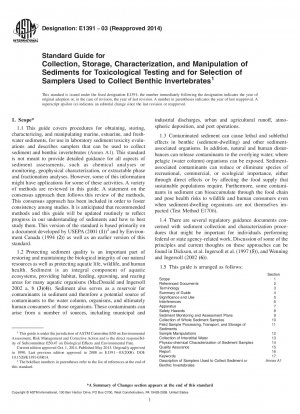ASTM E1391-03(2014)
Standard Guide for Collection, Storage, Characterization, and Manipulation of Sediments for Toxicological Testing and for Selection of Samplers Used to Collect Benthic Invertebrates
- Standard No.
- ASTM E1391-03(2014)
- Release Date
- 2003
- Published By
- American Society for Testing and Materials (ASTM)
- Status
- Replace By
- ASTM E1391-03(2023)
- Latest
- ASTM E1391-03(2023)
- Scope
5.1 Sediment toxicity evaluations are a critical component of environmental quality and ecosystem impact assessments, and are used to meet a variety of research and regulatory objectives. The manner in which the sediments are collected, stored, characterized, and manipulated can influence the results of any sediment quality or process evaluation greatly. Addressing these variables in a systematic and uniform manner will aid the interpretations of sediment toxicity or bioaccumulation results and may allow comparisons between studies.
5.2 Sediment quality assessment is an important component of water quality protection. Sediment assessments commonly include physicochemical characterization, toxicity tests or bioaccumulation tests, as well as benthic community analyses. The use of consistent sediment collection, manipulation, and storage methods will help provide high quality samples with which accurate data can be obtained for the national inventory and for other programs to prevent, remediate, and manage contaminated sediment.
5.3 It is now widely known that the methods used in sample collection, transport, handling, storage, and manipulation of sediments and interstitial waters can influence the physicochemical properties and the results of chemical, toxicity, and bioaccumulation analyses. Addressing these variables in an appropriate and systematic manner will provide more accurate sediment quality data and facilitate comparisons among sediment studies.
5.4 This standard provides current information and recommendations for collecting and handling sediments for physicochemical characterization and biological testing, using procedures that are most likely to maintain in situ conditions, most accurately represent the sediment in question, or satisfy particular needs, to help generate consistent, high quality data collection.
5.5 This standard is intended to provide technical support to those who design or perform sediment quality studies under a variety of regulatory and non-regulatory programs. Information is provided concerning general sampling design considerations, field and laboratory facilities needed, safety, sampling equipment, sample storage and transport procedures, and sample manipulation issues common to chemical or toxicological analyses. Information contained in this standard reflects the knowledge and experience of several internationally-known sources including the Puget Sound Estuary Program (PSEP), Washington State Department of Ecology (WDE), United States Environmental Protection Agency (USEPA), US Army Corps of Engineers (USACE), National Oceanic and Atmospheric Administration (NOAA), and Environment Canada. This standard attempts to present a coherent set of recommendations on field sampling techniques and sediment or interstitial water sample processing based on the above sources, as well as extensive information in the peer-reviewed literature.
5.6 As the scope of this standard is broad, it is impossible to adequately present detailed information on every aspect of sediment sampling and processing for all situations. Nor is such detailed guidance warranted because much of this information (for example, how to operate a particular sampling device or how to use a Geographical Positioning System (GPS) device) already exists in other published materials referenced in this standard.
ASTM E1391-03(2014) Referenced Document
- ASTM D1067 Standard Test Methods for Acidity or Alkalinity of Water
- ASTM D1126 Standard Test Method for Hardness in Water
- ASTM D1129 Standard Terminology Relating to Water
- ASTM D1426 Standard Test Methods for Ammonia Nitrogen In Water
- ASTM D3976 Standard Practice for Preparation of Sediment Samples for Chemical Analysis
- ASTM D4387 Standard Guide for Selecting Grab Sampling Devices for Collecitng Benthic Macroinvertebrates
- ASTM D4822 Standard Guide for Selection of Methods of Particle Size Analysis of Fluvial Sediments (Manual Methods)
- ASTM D4823 Standard Guide for Core Sampling Submerged, Unconsolidated Sediments
- ASTM E1241 Standard Guide for Conducting Early Life-Stage Toxicity Tests with Fishes
- ASTM E1367 Standard Guide for Conducting 10-day Static Sediment Toxicity Tests with Marine and Estuarine Amphipods
- ASTM E1525 Standard Guide for Designing Biological Tests with Sediments
- ASTM E1611 Standard Guide for Conducting Sediment Toxicity Tests with Polychaetous Annelids
- ASTM E1688 Standard Guide for Determination of the Bioaccumulation of Sediment-Associated Contaminants by Benthic Invertebrates
- ASTM E1706 Standard Test Method for Measuring the Toxicity of Sediment-Associated Contaminants with Freshwater Invertebrates
- ASTM E729 Standard Guide for Conducting Acute Toxicity Tests on Test Materials with Fishes, Macroinvertebrates, and Amphibians
- ASTM E943 Standard Terminology Relating to Biological Effects and Environmental Fate
- IEEE/ASTM SI 10 American National Standard for Metric Practice
ASTM E1391-03(2014) history
- 2023 ASTM E1391-03(2023) Standard Guide for Collection, Storage, Characterization, and Manipulation of Sediments for Toxicological Testing and for Selection of Samplers Used to Collect Benthic Invertebrates
- 2003 ASTM E1391-03(2014) Standard Guide for Collection, Storage, Characterization, and Manipulation of Sediments for Toxicological Testing and for Selection of Samplers Used to Collect Benthic Invertebrates
- 2003 ASTM E1391-03(2008) Standard Guide for Collection, Storage, Characterization, and Manipulation of Sediments for Toxicological Testing and for Selection of Samplers Used to Collect Benthic Invertebrates
- 2003 ASTM E1391-03 Standard Guide for Collection, Storage, Characterization, and Manipulation of Sediments for Toxicological Testing and for Selection of Samplers Used to Collect Benthic Invertebrates
- 2002 ASTM E1391-02 Standard Guide for Collection, Storage, Characterization, and Manipulation of Sediments for Toxicological Testing
- 1994 ASTM E1391-94 Standard Guide for Collection, Storage, Characterization, and Manipulation of Sediments for Toxicological Testing

Copyright ©2024 All Rights Reserved